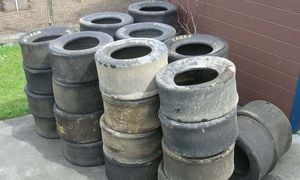No edit summary |
No edit summary |
||
| Line 11: | Line 11: | ||
General description | General description | ||
===Materials=== | ===Materials for Shingles=== | ||
# 36 Race Car Tires | |||
# Sharp Razor Blades | |||
=== | ===Materials for Roof=== | ||
# (3) 3/4" Plywood sheets | |||
# (2) 8ft 2"x4" | |||
# Screws | |||
# Miscelaneous wood that I had | |||
===Clients=== | [[Image:Coop.jpg|thumbnail|The Clients and the Coop|right]] | ||
===Clients/Site=== | |||
===Trial and Error=== | |||
As with any project there are always mistakes, or learning curves as some might say. So here is where I tell you about what didn’t work (for me). The initial tire concept was based on utilizing radial tires and that changed very quickly. The first tire I tried to cut was, to say the least, very smelly. I tried using a cutting wheel on the end of a drill (spinning at about 30,000RPM) and I found that while it would cut through the bead of the tire and all of the steel belts it wouldn’t cut the rubber, it just melted it. After breathing a cloud of burning rubber and trying it again wearing a breathing mask, I decided that it may not be the most “appropriate” method. That particular method took about an hour and a half with only 8 small shingles being produced. The next method I tried was a jigsaw; it didn’t even cut through the rubber. The tire was too flimsy and would shake, so the jigsaw couldn’t cut it if the tire didn’t stay still. I didnt even get one shingle out of that attempt. The last method I used on the radial tires was a hack saw and let’s just say that it would have taken more than a year to cut the shingles that I needed. It is because all of all of these trials that I realized slick racing tires were what I needed. | |||
===Method=== | ===The Method Used=== | ||
===Final Construction=== | ===Final Construction=== | ||
Revision as of 04:18, 4 May 2006
Introduction

An introduction goes here.
Information on Tires
Some informaton on chemical makeup and Recycling.
Project Description
General description
Materials for Shingles
- 36 Race Car Tires
- Sharp Razor Blades
Materials for Roof
- (3) 3/4" Plywood sheets
- (2) 8ft 2"x4"
- Screws
- Miscelaneous wood that I had

Clients/Site
Trial and Error
As with any project there are always mistakes, or learning curves as some might say. So here is where I tell you about what didn’t work (for me). The initial tire concept was based on utilizing radial tires and that changed very quickly. The first tire I tried to cut was, to say the least, very smelly. I tried using a cutting wheel on the end of a drill (spinning at about 30,000RPM) and I found that while it would cut through the bead of the tire and all of the steel belts it wouldn’t cut the rubber, it just melted it. After breathing a cloud of burning rubber and trying it again wearing a breathing mask, I decided that it may not be the most “appropriate” method. That particular method took about an hour and a half with only 8 small shingles being produced. The next method I tried was a jigsaw; it didn’t even cut through the rubber. The tire was too flimsy and would shake, so the jigsaw couldn’t cut it if the tire didn’t stay still. I didnt even get one shingle out of that attempt. The last method I used on the radial tires was a hack saw and let’s just say that it would have taken more than a year to cut the shingles that I needed. It is because all of all of these trials that I realized slick racing tires were what I needed.
The Method Used
Final Construction
Conclusions
Actual Results
Discussion
Hypotheses from results.